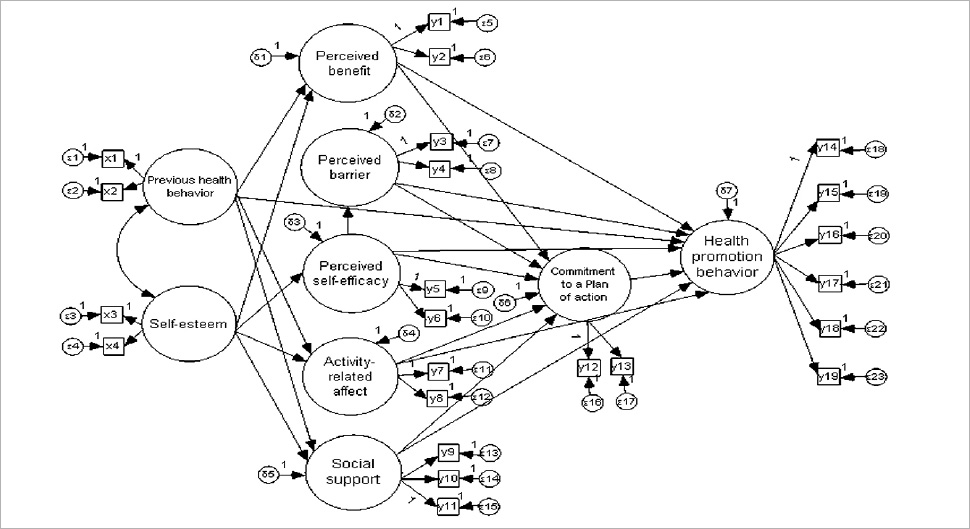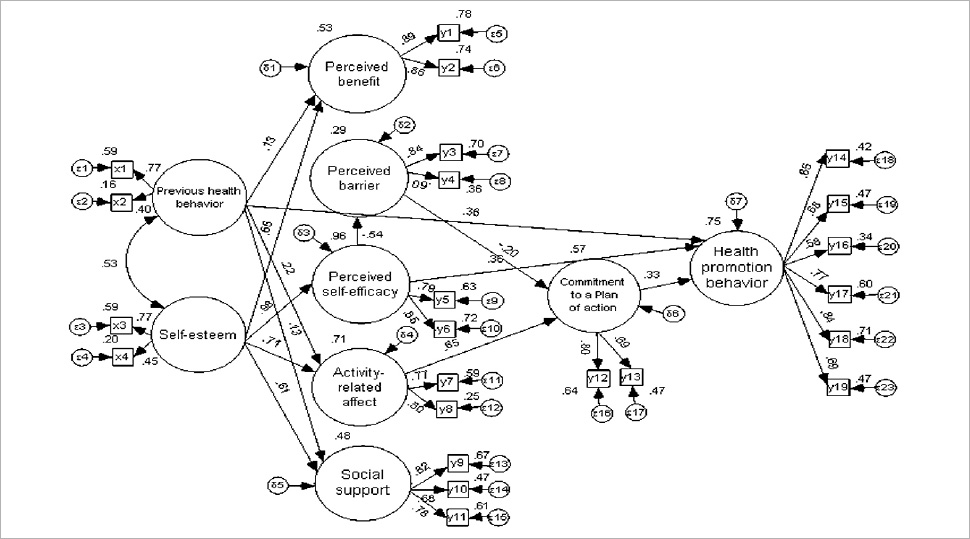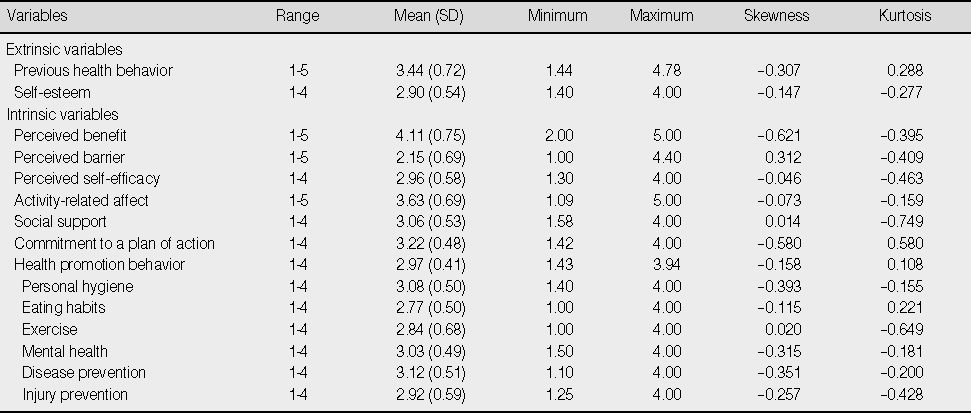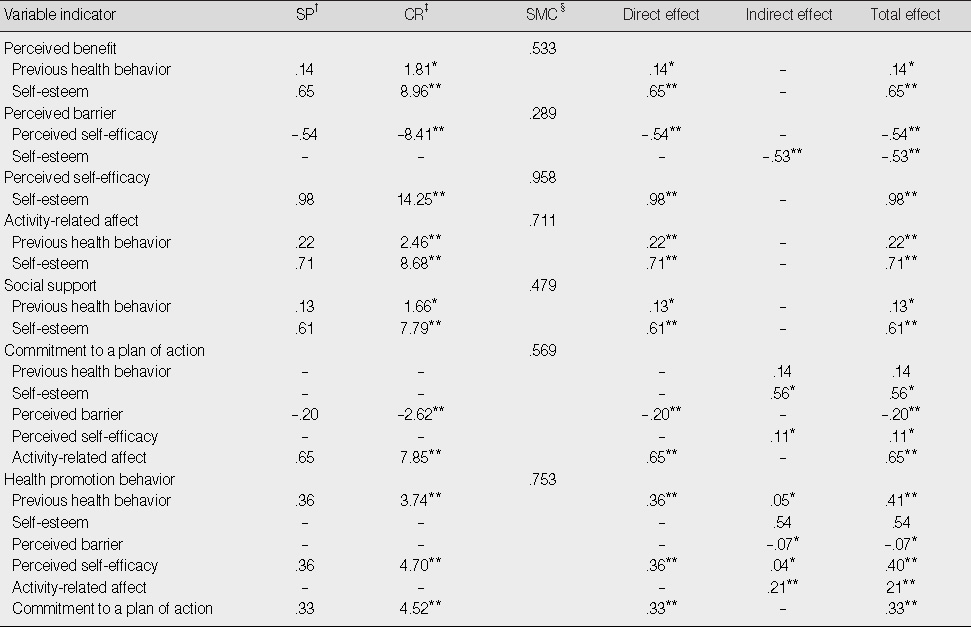Articles
- Page Path
- HOME > J Korean Acad Nurs > Volume 40(2); 2010 > Article
-
Original Article
- A Predictive Model of Health Promotion Behavior in Obese School-Age Children
- Mi Suk Jeon, Hyeon-Ok Kim
-
Journal of Korean Academy of Nursing 2010;40(2):264-276.
DOI: https://doi.org/10.4040/jkan.2010.40.2.264
Published online: April 30, 2010
1Health Teacher, Gosan Elementary School, Wanju, Korea.
2Professor, College of Nursing, Research Institute of Nursing Science, Chonbuk National University, Jeonju, Korea.
- Address reprint requests to: Jeon, Mi Suk. Gosan Elementary School, 148 Eupnae-ri, Gosan-myeon, Wanju 565-864, Korea. Tel: 82-63-263-4025, Fax: 82-63-263-4607, ymdje@hanmail.net
• Received: October 13, 2009 • Revised: October 19, 2009 • Accepted: April 1, 2010
Copyright © 2010 Korean Society of Nursing Science
Abstract
-
Purpose
- The purpose of this study was to propose and to test a predictive model that could explain and predict the health promotion behavior of obese school-age children in Korea.
-
Methods
- Participants for this study were 365 students from 13 elementary schools located in Jeonbuk Province, Korea. The data were analyzed using SPSS 15.0 program and Amos 7.0 program.
-
Results
- The results verified the factors that influence health promotion behavior of the participants. Important direct factors were prior health-related behavior, perceived self-efficacy, and commitment to a plan of action and indirect factors were perceived barrier and activity-related effect. These factors explained 75.3% of variance in the participants' health promotion behavior. The proposed model was concise and extensive in predicting health promotion behavior of the participants.
-
Conclusion
- Findings may provide useful assistance in developing effective nursing interventions for maintaining and promoting health promotion behavior in obese school-age children.
This article is based on a part of the first author's doctoral thesis from Chonbuk National University.
- 1. Ahn JM, Park JY. Effect of weight control program on weight, self-esteem, & body-consciousness in obese children. Korea Sports Research. 2004;15:439–451.
- 2. Ajzen I, Fishbein M. Understanding attitudes and predicting social behaviour. 1980;Englewood Cliffs, NJ, Prentice-Hall.
- 3. Bae BR. Structural equation modeling with Amos 7. 2007;Seoul, Chung Ram Book Publisher.
- 4. Bandura A. Social foundations of thought and action: A social cognitive theory. 1986;Englewood Cliffs, NJ, Prentice-Hall.
- 5. Braet C, Mervielde I, Vandereycken W. Psychological aspects of childhood obesity: A controlled study in a clinicaland nonclinical sample. Journal of Pediatric Psychology. 1997;22:59–71.ArticlePubMed
- 6. Cohen S, Hoberman HM. Positive events and social supports as buffers of life change stress. The Journal of Applied Psychology. 1983;13:99–125.
- 7. Cohen S, Mermelstein R, Kamarck T, Hoberman H. Sarason IG, Sarason BR. Measuring the functional components of social support. In: Social support: Theory research and application. 1985;The Hague, Martinus Nijhoff. 73–94.
- 8. Dietz WH. Overweight in childhood and adolescence. The New England Journal of Medicine. 2004;350:855–857.ArticlePubMed
- 9. Jeon BJ. Social psychology. 1974;Seoul, Kyung Moon Publishers.
- 10. Jeong SH. The effects of weight management educational program based problem-based learning (PBL) on self-efficacy, health promotion behavior and obesity index in obese children. 2006;Seoul, Korea University. Unpublished master's thesis.
- 11. Kim MH. A study on the relations of health promoting daily life style and self-efficiency about boys' obesity. 2000;Seoul, Chung-Ang University. Unpublished master's thesis.
- 12. Kim SH. A prediction model of health promotion behavior for school children. 2007;Seoul, Ewha Womans University. Unpublished doctoral dissertation.
- 13. Kim SJ, Yang SO, Jeong GH, Lee SH. Level of health promotion behavior practice in elementary school students. Journal of Korean Academy of Child Health Nursing. 2007;13:407–415.
- 14. Korean Society for the Study of Obesity. Clinical obesity. 2001;Seoul, Korea Medical Book Publisher.
- 15. Lee JI. A study on obese children's self-efficacy and health promotion behavior. 2001;Gyeongsan, Gyeongsan University. Unpublished doctoral dissertation.
- 16. Lee MJ. Construction of health promotion behaviors model for industrial workers. 2002;Seoul, Chung-Ang University. Unpublished doctoral dissertation.
- 17. Lee SJ, Kim SI, Lee PS, Khim SY, Park ES, Park YJ. Construct a structural model for health promoting behavior of chronic illness. Journal of Korean Academy of Nursing. 2002;32:62–76.ArticlePDF
- 18. Lee YM, Schwarzer R, Jerusalem M. Korean adaptation of the general self-efficacy scale. 1994;Retrieved April 2, 2008. from http://userpage.fu-berlin.de/~health/korean.htm.
- 19. Marlow DR, Redding BA. Textbook of pediatric nursing. 1988;6th ed. Philadelphia, W. B. Saunders Company.
- 20. Ministry of Health & Welfare. The third Korea national health and nutrition examination survey (KNHANES III), 2005. 2006;Seoul, Author.
- 21. Moon JS. A Study on the development of measuring tool for health belief in adult. 1990;Seoul, Yonsei University. Unpublished doctoral dissertation.
- 22. Moon SB. Basic concepts and applications of structural equation modeling. 2009;Seoul, Hakjisa Publisher.
- 23. Paek YM. Prediction model on health promotion behaviors in male office worker. 2005;Seoul, Ewha Womans University. Unpublished doctoral dissertation.
- 24. Park GS. A study on the relationship between self-efficacy and health promoting lifestyle profile of childhood obesity. 2002;Gwangju, Chosun University. Unpublished master's thesis.
- 25. Park YJ, Kim SI, Lee PS, Kim SY, Lee SJ, Park ES, et al. A structural model for health promoting behaviors in patients with chronic respiratory disease. Journal of Korean Academy of Nursing. 2001;31:477–491.ArticlePDF
- 26. Pender NJ. Health promotion in nursing practice. 1996;3rd ed. Stamford, CT, Appleton & Lange.
- 27. Rosenberg M. Society and adolescent self-image. 1965;Princeton, NJ, Princeton University Press.
- 28. Schwarzer R, Jerusalem M. Generalized perceived self-efficacy scale. 1993;Retrieved April 2, 2008. from http://web.fu-berlin.de/gesund/skalen/Language_Selection/Turkish/General_Perceived_Self-Efficac/hauptteil_general_perceived_self-efficac.htm.
- 29. School health and youth health promotion. World Health Organization. 2008;Retrieved April 2, 2008. from http://www.who.int/school_youth_health/en/.
- 30. Yun SN, Kim JH. Health-promoting behaviors of the women workers at the manufacturing industry-based on the Pender's health promotion model. Korean Journal of Occupational Health Nursing. 1999;8:130–140.
REFERENCES
Figure 1
Hypothetical model.
x1-x2=Previous health behavior; x3-x4=Self-esteem; y1-y2=Perceived benefit; y3-y4=Perceived barrier; y5-y6=Perceived self-efficacy; y7-y8=Activity-related affect; y9-y11=Social support; y12-y13=Commitment to a plan of action; y14-y19=Health promotion behavior.


Figure 2
Modified model with parameter estimates.
x1-x2=Previous health behavior; x3-x4=Self-esteem; y1-y2=Perceived benefit; y3-y4=Perceived barrier; y5-y6=Perceived self-efficacy; y7-y8=Activity-related affect; y9-y11=Social support; y12-y13=Commitment to a plan of action; y14-y19=Health promotion behavior.


Figure & Data
REFERENCES
Citations
Citations to this article as recorded by 

- A Prediction Model for Health Promoting Behavior in Obese Middle-Aged Women
Nohyun Bae, Oksoo Kim
Journal of Korean Academy of Fundamentals of Nursing.2022; 29(1): 84. CrossRef - The influence of mothers' health beliefs and attitudes on prevention of infectious diseases on preventive health behaviors of late school-aged children
Suchang Ham, Hanyi Lee
The Journal of Korean Academic Society of Nursing Education.2021; 27(3): 287. CrossRef - Effects of education in an obesity control program for obese homemakers on body fat and flexibility in Korea
Min‐Sun Song, Yong‐Kwon Yoo, Nam‐Cho Kim
Nursing & Health Sciences.2014; 16(3): 352. CrossRef - Elementary school children's perceptions of traditional Korean foods, based on the health belief model
KyoungAe Lee
Korean Journal of Nutrition.2013; 46(1): 86. CrossRef - Evaluation of items for the food behavior checklist and nutrition quotient score on children in rural areas of Gyeongbuk
Jung-Sun Yoo, Young-Sun Choi
Journal of Nutrition and Health.2013; 46(5): 427. CrossRef - Perception of the Importance of Health Promotion Behavior for Infants and Toddlers according to Mothers of Children in this Age Group and Graduate Students in Nursing
Kyung-Sook Bang, Mi-Kyung Kwon, Mi-Young Choi, Bo-Yun Huh, Sophia-Jihey Chung
Journal of Korean Academy of Child Health Nursing.2012; 18(2): 60. CrossRef
A Predictive Model of Health Promotion Behavior in Obese School-Age Children


Figure 1
Hypothetical model.
x1-x2=Previous health behavior; x3-x4=Self-esteem; y1-y2=Perceived benefit; y3-y4=Perceived barrier; y5-y6=Perceived self-efficacy; y7-y8=Activity-related affect; y9-y11=Social support; y12-y13=Commitment to a plan of action; y14-y19=Health promotion behavior.
Figure 2
Modified model with parameter estimates.
x1-x2=Previous health behavior; x3-x4=Self-esteem; y1-y2=Perceived benefit; y3-y4=Perceived barrier; y5-y6=Perceived self-efficacy; y7-y8=Activity-related affect; y9-y11=Social support; y12-y13=Commitment to a plan of action; y14-y19=Health promotion behavior.
Figure 1
Figure 2
A Predictive Model of Health Promotion Behavior in Obese School-Age Children
Descriptive Statistics of Study Variables (N=365)
Parameter Estimates for Modified Structural Model and Standardized Direct, Indirect, and Total Effects in Modified Model (N=365)
*p<.05; **p<.01.
†Standardized parameter; ‡Critical ratio; §Squared multiple correlation.
Table 1
Descriptive Statistics of Study Variables (N=365)
Table 2
Parameter Estimates for Modified Structural Model and Standardized Direct, Indirect, and Total Effects in Modified Model (N=365)
* †Standardized parameter; ‡Critical ratio; §Squared multiple correlation.
 KSNS
KSNS
 E-SUBMISSION
E-SUBMISSION


 Cite
Cite

